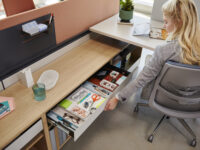Just because the demand for hybrid working environments is at an all time high, doesn’t mean in-person collaboration should be sacrificed. Despite remote work having numerous benefits for both mental health and productivity, studies show that coming together to have group discussions helps build team chemistry, build trust, and exercise company core values. This alone makes designing an office that nurtures collaboration essential for attracting (and retaining) the best talent out there.
Designing an office made for both hybrid work and collaboration starts with assessing your unique workspace. Read on to learn how you can use intuitive office design to attract hybrid workers and boost productivity.
Assessing Your Office Space
The idea of reconfiguring a workspace for hybrid work is to create an environment with its own set of unique benefits. As you assess your current office setup, remember that it serves as the home base for your hybrid employees. It can be challenging for business leaders to step back and identify collaboration zones within their existing layout, which is why working with a professional office space planner can greatly enhance the outcome. By evaluating your current layout, you can identify which areas to prioritize. This allows you to make the most informed decisions when it comes to investing in collaboration spaces that will be most effective for your team.
Designing Your Office for Collaboration
To create a collaborative office space that attracts hybrid workers and boosts productivity, it’s essential to consider your office design. Here are some tips for designing an office that promotes collaboration:
Creating Open, Flexible Spaces To Encourage Group Discussions
One of the key elements of a collaborative office is an open floor plan that encourages interaction and idea sharing. Consider removing barriers such as cubicle walls and creating communal workspaces, like shared tables or lounge areas. These open spaces can encourage hybrid workers to brainstorm and engage with each other.
Incorporating Technology To Facilitate Communication
In a hybrid work environment, technology is essential for streamlining communication. Consider implementing tools like video conferencing software, instant messaging, and project management software to connect hybrid workers across locations. Additionally, incorporating interactive displays and smart boards into your office design can help foster collaboration.
Providing Amenities That Promote Collaboration, Such As Whiteboards And Project Spaces
In addition to open spaces and technology, it’s important to provide amenities that encourage collaboration. Whiteboards, bulletin boards, and other interactive displays can facilitate brainstorming sessions and idea sharing. Project spaces that are designed specifically for collaboration can also encourage hybrid workers to work together and come up with creative solutions.
By designing an office that promotes collaboration and engagement, you can attract hybrid workers and boost productivity in your organization. Incorporating open spaces, technology, and collaboration amenities can create a workplace culture that values collaboration and fosters innovation.
Encouraging In-Person Discussions
One of the biggest advantages of hybrid work is the flexibility it offers, but this can also make it more challenging to encourage in-person discussions. To help attract hybrid workers to the office and boost productivity no matter where they’re at, consider these tips:
Offer opportunities for hybrid workers to work in the office: Depending on your company’s policies and hybrid work arrangements, you may be able to offer hybrid workers the option to work in the office for part of the week or for specific projects. Make sure your office space is designed to accommodate hybrid workers with flexible workstations, comfortable seating, and access to necessary tools and technology.
Schedule regular team meetings and collaboration sessions: Encourage in-person collaboration by scheduling regular team meetings and brainstorming sessions. These can be held in a designated collaboration space or in a conference room with whiteboards and other tools for group work.
Encourage cross-functional collaboration and idea sharing: Create opportunities for employees from different departments or teams to come together and share ideas. For example, you could organize cross-functional projects or create a shared workspace where employees can come together to collaborate on projects or discuss ideas.
By encouraging in-person collaboration, you can help hybrid workers feel more connected to their colleagues and the company. This promotes a healthy, innovative culture that can help boost productivity and drive success.
Supporting Remote Collaboration
Hybrid work requires not only in-person collaboration, but also effective remote communication to ensure all team members are included and engaged. As such, it’s important to provide the technology and resources necessary for remote workers to connect with their in-office colleagues.
Provide reliable technology: As we mentioned above, ensure that remote workers have access to reliable communication tools, such as video conferencing software, chat apps, and project management tools. This will enable them to participate fully in meetings and collaborate on projects with in-office workers.
Establish clear guidelines and processes: Set clear guidelines for remote collaboration, including expectations for communication and response times. Establish clear processes for project management, task delegation, and file sharing to ensure that everyone is on the same page.
Encourage participation: Encourage remote workers to participate in team meetings and collaboration sessions. Make sure they have equal opportunities to share their ideas and thoughts and that their contributions are valued.
By providing the technology and resources necessary for remote collaboration, you can ensure that all team members, whether in the office or remote, are able to collaborate effectively and contribute to the success of the team.
Office Space Planning: Key to Creating a Collaborative Workplace for Hybrid Workers
In today’s hybrid work environment, designing an office space for collaboration is essential to attracting top talent and boosting productivity. By assessing your current office space, designing for collaboration, encouraging in-person collaboration, and supporting remote collaboration, you can create an environment that fosters teamwork, communication, and innovation. With these tips in mind, you can transform your office into a hub of collaboration that attracts and retains hybrid workers and drives your business forward.
Ready to start designing your office for collaboration? Contact King Business Interiors for workspace design and branding expertise. Our team can help you create an office environment that attracts top talent and drives productivity. Explore our space planning services page to learn more and schedule a consultation today!



